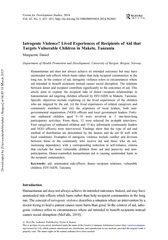Iatrogenic Violence? Lived experiences of recipients of aid that targets vulnerable children in Makete, Tanzania
Peer reviewed, Journal article
Published version
Permanent lenke
https://hdl.handle.net/1956/9565Utgivelsesdato
2014Metadata
Vis full innførselSamlinger
Originalversjon
https://doi.org/10.1080/08039410.2014.962601Sammendrag
Humanitarian aid does not always achieve its intended outcomes but may have unintended side-effects which harm rather than help recipient communities in the long run. In the context of aid, iatrogenic violence refers to circumstances where aid intended to benefit recipients instead causes social disruption. The relations between donor and recipient contribute significantly to the outcomes of aid. This article aims to explore the recipient side of donor–recipient relationships in humanitarian aid targeting children affected by HIV/AIDS in Makete, Tanzania. Specific objectives include exploring (i) the lived experiences of the children who are targeted by the aid, (ii) the lived experiences of related caregivers and community members and (iii) the responses of local leaders, both non-governmental organisation (NGO) officers and local government leaders. Forty-one orphaned children aged 9–18 were involved in 3 one-hour-long participatory activities. From these, 12 were selected for in-depth interviews. Four caregivers of orphaned children and 15 key informants (community leaders and NGO officers) were interviewed. Findings show that the type of aid and method of distribution are determined by the donors and do not fit well with local conditions. Examples of iatrogenic violence include conflict and division between those in the community who receive aid and those who do not, increasing dependency with a corresponding reduction in self-reliance, criteria that exclude the most vulnerable children from aid and passivity and non-participation. Donor-controlled humanitarian aid is causing unintended harm in the recipient communities.

